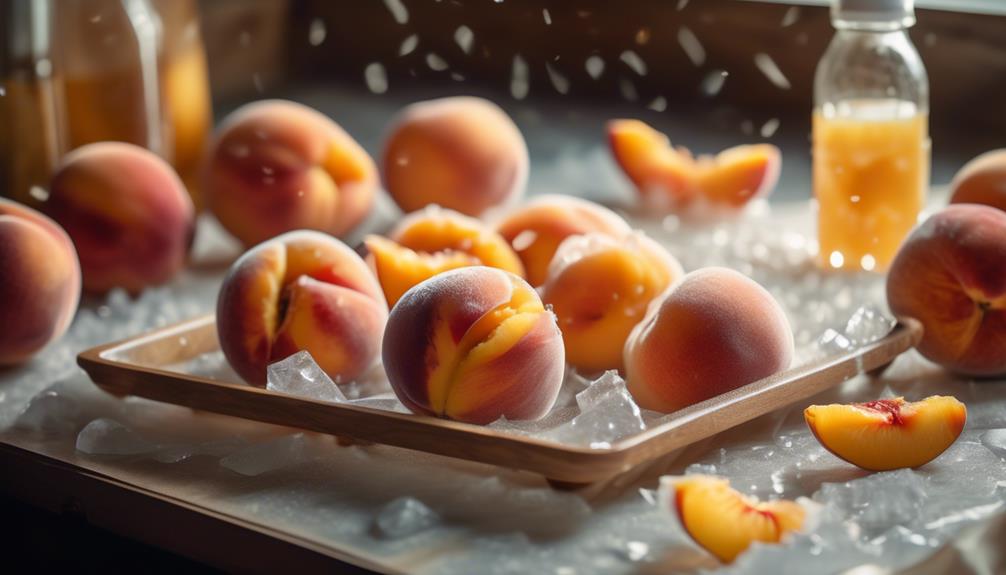Imagine the horror: you're about to freeze your bountiful peach harvest, only to find you're fresh out of lemon juice—the horror, the travesty! But, fear not, you can still preserve those juicy gems without the citrus.
First, you'll want to pick the ripest, most unblemished peaches you've got; no one's freezing second-rate fruit on our watch. You'll wash them thoroughly, since we're not aiming to preserve any extra 'natural flavors' from your backyard.
Now, you might be wondering how to keep those slices looking as fresh and bright as a summer's day without our tangy friend, lemon. Well, there's a nifty little trick involving blanching that will lock in the color and flavor, and you'll be using sugar, which is more than just a sweetener in this preservation dance.
So, if you're keen on discovering the secret to vibrant, sweet, and lemon-juice-free frozen peaches, prepare your taste buds for a journey through the art of freezing peaches with a twist.
Key Takeaways
- Look for ripe, fragrant peaches that yield slightly to gentle pressure.
- Blanch peaches by boiling briefly and then cooling in ice water.
- The sugar pack method preserves the peaches and draws out natural juices.
- Store peaches in airtight containers or heavy-duty freezer bags.
Selecting the Perfect Peaches
To ensure your peaches freeze well, look for ripe, fragrant fruit that yields slightly to gentle pressure. Peach varieties are plentiful, but not all are created equal when it comes to freezing. Freestone peaches, for example, are a practical choice as their flesh separates easily from the pit, making them less fussy to prepare for freezing.
You'll want to become familiar with ripeness indicators specific to the type of peach you've got your eye on. Generally, a ripe peach has a sweet aroma and a deep yellow undercolor, regardless of whether it's a white or yellow peach. You might find some blushing red on their cheeks, but this isn't a reliable sign of ripeness – it's more about variety and sun exposure.
Give the peach a soft squeeze with your fingers; if it's firm but not hard, and gives in slightly, it's just right. Avoid those with green near the stem, as they're not fully ripe. Peaches should feel heavy for their size, a sign that they're juicy and at peak ripeness. Remember, once you've picked your perfect peaches, you'll want to freeze them promptly to capture that just-right flavor and texture.
Prepping Your Peaches
Begin by washing your peaches thoroughly to remove any dirt or residue from their skins. Choose ripe, but firm peach varieties for the best results when freezing. After washing, you'll need to blanch your peaches. This process involves briefly boiling them and then plunging them into ice water. Blanching makes it easier to peel the peaches and helps preserve their color and texture.
Once blanched, the skins should slip off easily. Now it's time to use your cutting techniques. Slice the peaches according to your preference, but remember that uniform slices will freeze and thaw more evenly. Be sure to remove the pits and any bruised or soft spots, as these can affect the quality of your frozen peaches.
Here's a handy table to guide you through the preparation stages:
| Stage | Description |
|---|---|
| Washing | Ensure peaches are clean and free from residue. |
| Blanching | Boil briefly, then cool in ice water for easy peeling. |
| Cutting | Slice uniformly, remove pits, and discard imperfections. |
Sticking to these practical steps will ensure your peaches are well-prepped and ready for freezing, giving you a taste of summer even in the colder months.
Blanching to Retain Color
Blanching your peaches, a step crucial for maintaining their vibrant color, involves immersing them in boiling water for a short time before plunging into ice water to halt the cooking process. This method isn't just practical, but it's a tried and true technique for color preservation across various peach varieties.
Start by bringing a large pot of water to a rolling boil. While you wait for the water to heat, prepare a bowl of ice water. Once the water is boiling, gently lower your peaches into the pot. You don't need long—just enough time to loosen their skins, typically around 30 to 60 seconds.
After the quick dip in the hot bath, use a slotted spoon to immediately transfer the peaches to the ice water. This shocks them, stopping the cooking process and locking in their bright hue. Let the peaches cool down in the ice bath, which should take about the same time they spent in the boiling water.
Once cooled, you can easily peel the peaches. The blanching has done its magic, not only making the peeling simpler but also helping to preserve the peach's natural color without the need for lemon juice. Your peaches are now ready for the next step in the freezing process, looking as fresh as the day they were picked!
The Sugar Pack Method
Once your peaches are peeled and ready, the sugar pack method offers a sweet solution for freezing them while enhancing both their flavor and texture. Begin by mixing sugar and water to create a thick syrup, keeping in mind that for every four cups of sliced peaches, you'll typically need three-quarters to one cup of sugar.
In a large bowl, gently toss your peach slices with the sugar until they're well coated. This process draws out the natural juices, creating a protective syrup that helps preserve the peaches during freezing. As an alternative to a heavy sugar mix, you can experiment with syrup variations by reducing the sugar content for a lighter coat, which is especially useful if you're watching sugar intake.
When it comes to packing alternatives, you've got options. You can lay the sugared peaches on a baking sheet to freeze individually before transferring them to a container or bag, which prevents clumping. Alternatively, pack them directly into freezer-safe containers or bags, layering them with additional sugar if desired. Just make sure to leave some headspace for expansion, seal tightly, and label with the date before placing them in the freezer.
Freezing and Storage Tips
To ensure your peaches remain at their peak of freshness, store them in airtight containers or heavy-duty freezer bags, squeezing out as much air as possible before sealing. Different peach varieties, from clingstones to freestones, can affect the texture after freezing, so remember that some may freeze better than others. For the best flavor retention, consider vacuum sealing, which can significantly extend the life of your frozen peaches by preventing freezer burn and oxidation.
Here are a few tips to make the most of your peach freezing endeavor:
- Label and Date: Always label your containers or bags with the date and variety of peach. This helps you rotate your stock and use the oldest ones first.
- Lay Flat to Freeze: If you're using bags, lay them flat in the freezer until solid to save space and allow for quicker thawing.
- Vacuum Sealing: Invest in a vacuum sealer if you plan to freeze peaches regularly. It's worth the upfront cost for the long-term savings in quality and taste.

